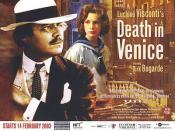Death in Venice In Death in Venice, Thomas Mann takes the reader on an adventure, as seen through the eyes of a dying artist. Gustav von Aschenbach is this man, and his thoughts and actions are brought vividly to life through the author's use of symbolic allusions, historical detail, and psychological realism. Mann's setting of the story in his own world and time lends a semi-autobiographical aire to Death in Venice. His reference to the year, 1911, and to the threat of peace in Europe, gives the reader a sense of the historical, rather than the fictional. Once in Venice, the attempt by the local government to suppress news of the plague reaches all the way down through the ranks of citizenry to the hotel barber. The cover-up of the deadly epidemic, and the uneasy relationship between the citizenry of Venice and the foreigners, reflects the political climate in Europe at the time.
No one seems to be trustworthy, everyone has ulterior motives for their suspect behavior, and no one exhibits any great sense of humanitarianism. In addition, Mann's familiarity with and use of actual street names, and his graphic descriptions of landmarks and buildings, serve to make Aschenbach's world a more concrete place.
This very real, solid world is offset by the excessively symbolic form in which Aschenbach relates his experiences. Most everything he sees and partakes in is broken down into an allusion, which seems to lend a more grandiose tint to otherwise ordinary experiences. The man he sees at the station in Munich symbolizes an exotic, far-off land, and the man's red hair and facial structure bring to mind visions of the devil. Aschenbach's desire to travel being brought on by the sight of this man signifies Satan's beguiling nature leading lost souls down the...


